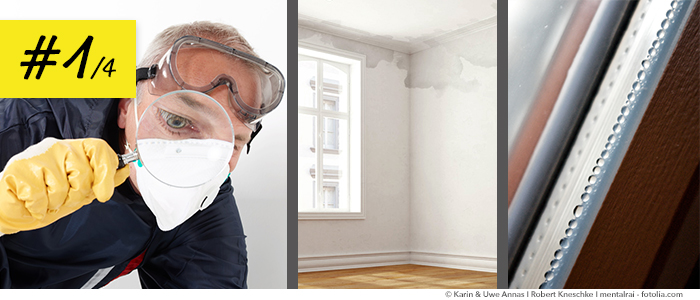
It’s a hard nut to crack – sometimes even for recognised experts and restoration companies – when it comes to investigating the source of mould. Although it is a basic requirement that there has to be a proportional level of damp for every mould outbreak, it is nevertheless anything but a simple task to localise the sources of spreading damp. Learn what you need to be aware of in our four-part advisory series…
Professional restoration starts by recording the possible causes and extent of the damage. As was determined at the beginning, damp conditions are an essential prerequisite for every instance of a mould outbreak – and localising the sources sometimes requires a consolidated structural inspection.
After the first visual inspection, the temperature and humidity measurements should be able to give the first indications of damage formation. For example, by measuring the surface temperature of walls by means of damage-free analysis methods in accordance with the dielectric process.
Long-term measurements and long-term solutions – heat and ventilate correctly
Does mould damage arise exclusively on the surface of building structures that cool more quickly? Or on those that already have a higher moisture content due to their utilisation or plainly because they are just poorly ventilated? As an example of how to get clarity on this issue, using data loggers, through which the temperature and moisture in ambient air can be determined, is highly recommended. Of course the correct heating and ventilation is always an issue: with the aim of saving energy, the insulation on window structures has been considerably improved over the last few years. But what about when thermal insulation systems or internal insulation detrimentally and considerably alter a functioning structure?
Answers to these and other questions can be found in our advisory series
-
2/4 “Where is the damp coming from?” – Damp on material and surfaces
Damp on mineral building materials as well as on wood and wooden materials can be determined using electric resistance measurements and capacitive measuring methods. How to best utilise the measuring devices …
-
3/4 “Where is the damp coming from?” – Determining air temperature and humidity
Using thermo-hygrometers, a building’s indoor climate can be determined. What you need to be aware of …
-
4/4 “Where is the damp coming from?” – Heating and ventilating correctly
Heating and ventilating incorrectly not only impairs indoor climates, but also increases the risk of mould formation. Therefore what you should be aware of when heating and ventilating ….

